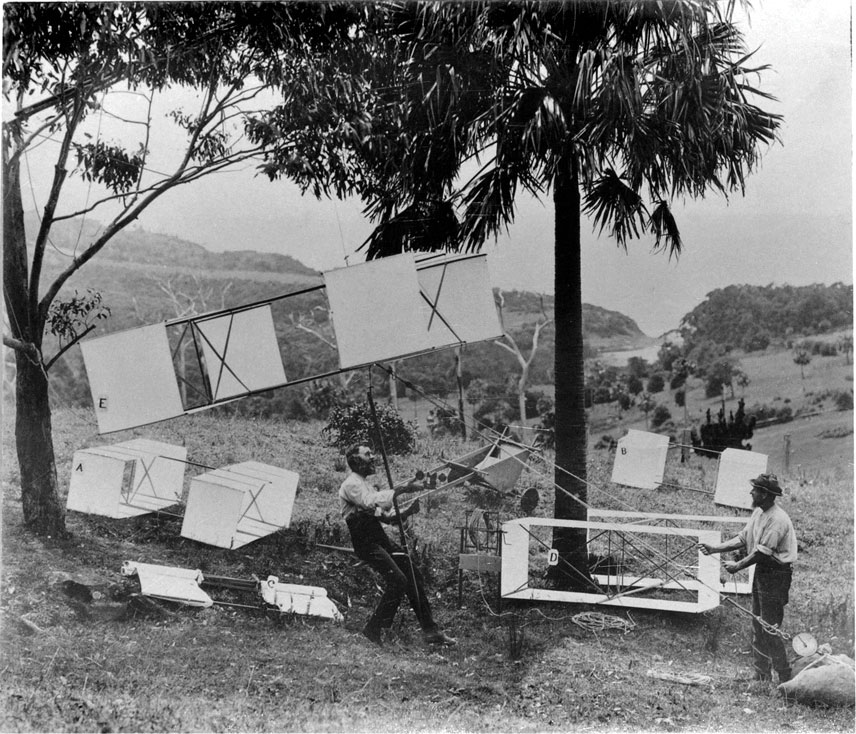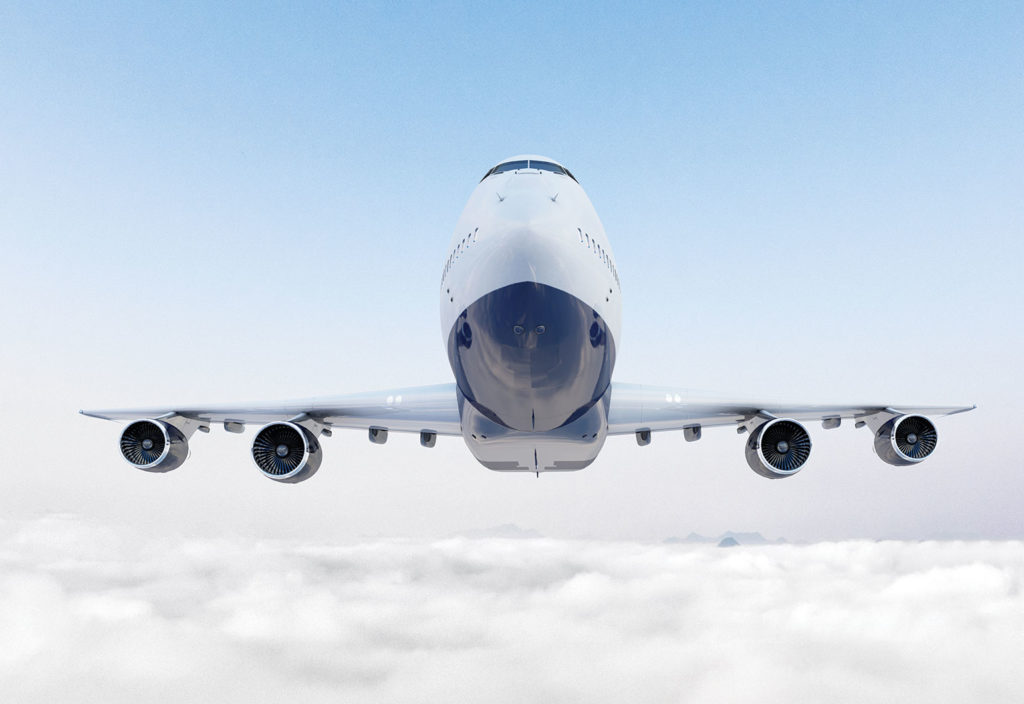In the early days of flight, Australia’s aviators were engineers experimenting with box-kites and gliders. Today, it’s surveillance and high-tech systems.
The first fixed-wing aircraft to fly in Australia took off at Narrabeen Beach on 5 December 1909. It was a glider piloted by an engineering married couple: George Augustine and Florence Mary Taylor.
The Taylors were influential presences in the Sydney of the early 20th century; the architectural historian Max Freeland described them as “possibly the most amazing couple in Australia’s history”.
George Taylor, who built the glider in his Redfern workshop, started his career as a journalist and cartoonist, finding company among the bohemian socialites of the turn-of-the-century before developing an interest in the new pursuit of aviation.
Taylor was influenced by Lawrence Hargrave, an engineer and pioneer in early aeronautics. In the late 19th century, Hargrave developed curved aerofoils and a rotary engine, and, most influentially, experimented with using box kites as a means of flight.
In 1894, at Stanwell Park on the New South Wales south coast, Hargrave lifted himself 5 m off the ground with one of his kites. Some features of the design would be echoed in Wilbur and Orville Wright’s Flyer, which made the world’s first powered flight nine years later, though the Wright Brothers denied that Hargrave was an inspiration.

But Hargrave’s ideas did make their way into Taylor’s design. The glider, made with a coachwood frame and covered with oil calico, used a box-kite tail for balance.
Until take-off, the machine was held down by a team of assistants.
“At the signal to let go the machine was well lifted by the wind, and by careful manipulation on the part of Mr Taylor it shot towards the ocean 98 yards away in a series of curves from 3 ft to 15 ft above the ground,” the Sydney Morning Herald wrote that week.
Ahead of their time
Florence Taylor took the second flight on the glider — immediately after her husband.
The first Australian woman to qualify as an engineer, Taylor studied at Sydney’s Marine Engineer’s College under Frederick Stowe, for whom she did clerical work. She also studied architecture at Sydney Technical College, where she was the only woman in the class.
Beyond aviation, the Taylors oversaw a publishing empire, producing journals centred on their interests in engineering, architecture and town planning, including Building, Construction, and Australasian Engineer.
George Taylor founded the Institution of Local Government Engineers of Australasia, which is today known as the Institute of Public Works Engineering Australasia, a technical college of Engineers Australia.
George Taylor died young, drowning in his bathtub after an epileptic seizure, but Florence maintained the couple’s legacy. She became the first woman to join the UK Institution of Structural Engineers and continued to publish Australasian Engineer.
She put forward many ambitious schemes for the city of Sydney that were dismissed as outlandish but have since come to fruition, such as the construction of a tunnel beneath Sydney Harbour.
She grew wealthy and became known as an imposing personage in mid-century Sydney, notable for her at-times controversial political stances — ranging from feminist to nationalistic — and for her ostentatious sense of style.
A year after the Taylors’ glider flight, an Australian-designed and built aircraft took to the air; this one operated under its own power.
The Duigan pusher biplane was created and flown by John Robertson Duigan, an electrical and motor engineer who launched the aircraft at his father’s sheep station in Mia Mia, central Victoria.
Trained at Finsbury Technical College and Battersea Polytechnic in London, Duigan designed his plane using a postcard of the Wright Brothers craft and papers written by the American-British inventor Hiram Maxim.
Following the inaugural flight of the Taylors’ glider, Australians had made powered flights using imported aircraft, but Duigan’s machine was the first to be designed and flown locally.
His first attempt stayed off the ground for around 6 m, but later flights would top 180 m in the air.
The experience prepared Robertson for the coming First World War; a lieutenant in the Australian Flying Corps, he saw action over France in 1918 and was awarded the Military Cross for gallantry.
Duigan’s journey from hobbyist to military hero demonstrates the mercurial state of Australian aviation in the early 20th century.
Men and women, dilettantes and innovators, flocked to an exciting new technology that quickly became the basis for new ways of fighting, new forms of business, and new types of engineering.
Box kites to Boeing
A century later, aerospace engineering is infinitely more advanced: the product of years of research and millions of dollars of investment.
But Australians continue to push innovation forward, producing new ideas and working on the most cutting-edge technology.
Taylah Griffin is a Graduate Systems Engineer with Boeing Defence Australia. Although her work involves state-of-the-art surveillance and communications technology, her interest in engineering derives from the same curiosity as those pioneers of flight.
“I grew up in Gordonvale, which is a rural sugarcane town in part of Queensland,” she told create.
“I didn’t have a lot of exposure to aerospace and planes … I think that the foreignness of it was what sparked my interest.”
This interest took Griffin from her small-town home outside Cairns to Queensland University of Technology (QUT), 1600 km away in Brisbane.
At first, Griffin studied law, not engineering. It didn’t suit her.
“I thought, ‘I’m going to change and go back to what I like’, and that was STEM,” she says.
“QUT offers the Electrical and Aerospace Engineering Degree, and that just seemed like the perfect fit for me. After I made the change, life was so much easier.”
An internship at Qantas followed, and then a mentor suggested she apply to Boeing’s internship program. The aerospace giant offered her a job before she had even graduated.
“I know that a lot of people coming out of uni really struggle to find jobs, so I felt very lucky,” she said.
The program on which Griffin works is the Boeing 737 E7-A Airborne Early Warning and Control (AEW&C) Wedgetail. A surveillance, communications, and battlefield management platform, it is undergoing a major upgrade to meet interoperability requirements.
“The aircraft has a number of subsystems,” Griffin said.
“When the systems teams create upgrades and modifications, those upgrades and mods filter into the test team, which is where I work.”
This work, she said, involves flight, ground and software testing.
“The role of testing is to ensure all systems are working as they should,” she said.
“When we identify systems that could work better or need refinement, we need to troubleshoot and figure out solutions, go back to liaise with the subsystems and to develop fixes.”
In the future, Griffin hopes to move into a leadership role — both on the Wedgetail team and in the community more generally.
“Boeing here in Australia also has a really great Reconciliation Action Plan that we actively work to show our commitment to Indigenous Australia,” she said.
“Being Indigenous myself, I would love to also lead that sort of space.”
A Gangalu woman, Griffin is the first Aboriginal person in Australia to graduate with honours in electrical and aerospace engineering. She sees herself as having a responsibility to give back to the community.
“I would personally love to help to start change in corporate Australia and increase Indigenous participation,” she said.
“STEM is the future and only one per cent of STEM roles are currently filled by Indigenous Australians.”
Her efforts include returning to northern Queensland to promote STEM in rural schools.
“To give them visibility around Boeing and what Boeing does,” she explains.
“Just because you come from a rural area doesn’t mean that you have to stay there.”
It’s one more way Australia is shaping its aerospace future — from box kites to high-tech defence programs and beyond.
Top honours
Griffin has already attracted notice outside the company for her work.
In 2018, the CSIRO honoured her with an Aboriginal and Torres Strait Islander Tertiary Student STEM Achievement Award.
“To be recognised amongst the talented other finalists was just absolutely amazing,” she told create.
“The other finalists are doing some really innovative, creative work and to be called up was an incredible honour.”
She points to low inclusion rates in STEM among Aboriginal and Torres Strait Islander people as a reason for the award’s importance.
“Those awards really put a spotlight on Indigenous excellence,” she said.
“It helps to create visibility around making STEM accessible for everyone.”
Since then, Griffin has been nominated as a finalist in the Rising Star category of Australian Defence Magazine’s Women in Defence awards.
“Those awards recognise women in defence, and not just typical defence — Army, Navy, Air Force — also defence industry and contractors,” she said.
“I know that it’s pretty competitive so, once again, I’m extremely honoured to be recognised.”
The winner will be announced this month. Griffin said the awards let her know “just to keep it up”.
“I think that just gives validation to me that I’m going in the right direction and I’m doing some good work,” she said.
This article originally appeared as “Taking Australia to the skies” in the July issue of create magazine.
